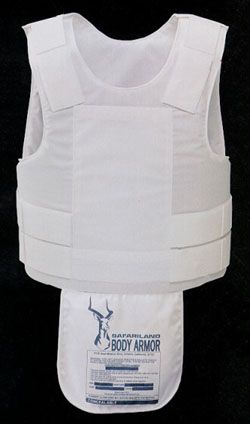Introduction
That depends.
Bulletproof vest standards in the United States are set and administered by the National Institute of Justice (NIJ), the research and development branch of the Department of Justice (DOJ). The NIJ does a variety of studies including everything from testing stun guns and facial recognition technology to proposing the best communication equipment for law enforcement agencies. NIJ standards for Bulletproof vests and gear are defined in the new "Ballistic Resistance of Personal Body Armor," NIJ Standard-0101.04.
Generally speaking Type III-A armor is the about all that one can expect to encounter concealed. If you don't see armor, you know it's not type III or IV as Types III and IV are both so bulky as to have to be deployed as tactical vest type armors. Types III and IV require the use of "rifle plates" to stop rifle rounds. In general Type III armor employs a steel rifle plate over the chest. Type IV armor uses ceramic plates.
M193 and M855 at anything greater than 2200 fps will generally defeat all body armor up to and including Type IIIA. How much damage those rounds will do AFTER penetration is guesswork. In shorter barrels (14.5" and below) that damage is likely to be limited and wound profiles in such instances will resemble .22LR hits. With higher velocities it's still hard to imagine explosive fragmentation at anything but point blank range but M193 and M855 will certainly defeat all soft armor.
It is worth noting that Type IV armor is only required to withstand ONE hit in the specification. Many ceramic armor plates are designed to shatter on the impact of a round and lose their ballistic protection as a result.
(As a data point, one test on Chinese steel core 7.62 39mm ammo against a sheet of auto glass, in front of two pieces of sheet metal, two pieces of level IIA body armor, heavy denim, penetrated all barriers and then into the gelatin four inches).

Type IIIA body Armor

A Type III rifle plate struck with two rounds of: M193 (upper right) M855 (Lower Right) 7.62 NATO (Left) at 25 feet
(Plate photo courteously provided by and Copyright BulletProofME.com Body Armor)
FACTS:
-
NIJ's first standard, 0101.00, Ballistic Resistance of Police Body Armor, was published in March 1972.
-
NIJ's first standard, 0101.00, Ballistic Resistance of Police Body Armor, was published in March 1972.
-
A revised standard, STD-0101.01 was published in December 1978. In March 1985, NIJ amended the standard, issuing STD-0101.02 to take into account armors' susceptibility to angle shots and multi-shot assaults. STD-0101.03 was released in 1987. Ballistic Resistance of Personal Body Armor, NIJ Standard-0101.04 was published in 2000 and is the first revision in 13 years.
-
NIJ Standard-0101.04 establishes six formal armor classification types, as well as a seventh special type, as follows:
-
Type I (.22 LR; .380 ACP). This armor protects against .22 long rifle lead round nose (LR LRN) bullets, with nominal masses of 2.6 g (40 gr), impacting at a minimum velocity of 320 m/s (1050 ft/s) or less and against .380 ACP full metal jacketed round nose (FMJ RN), with nominal masses of 6.2 g (95 gr), impacting at a minimum velocity of 312 m/s (1025 ft/s) or less.
-
Type II-A (9mm; .40 S&W). This armor protects against 9mm full metal jacketed round nose (FMJ RN) bullets, with nominal masses of 8.0 g (124gr), impacting at a minimum velocity of 332 m/s (1090 ft/s) or less and .40 S&W caliber full metal jacketed (FMJ) bullets, with nominal masses of 11.7 g (180 gr), impacting at a minimum velocity of 312 m/s (1025 ft/s) or less. It also provides protection against Type I threats.
-
Type II (9mm; .357 Magnum). This armor protects against 9mm full metal jacketed round nose (FMJ RN) bullets, with nominal masses of 8.0 g (124gr), impacting at a minimum velocity of 358 m/s (1175 ft/s) or less and .357 Magnum jacketed soft point (JSP) bullets, with nominal masses of 10.2 g (158 gr), impacting at a minimum velocity of 427 m/s (1400 ft/s) or less. It also provides protection against Type I and Type IIA threats.
-
Type III-A (High Velocity 9mm; .44 Magnum). This armor protects against 9mm full metal jacketed round nose (FJM RN) bullets, with nominal masses of 8.0 g (124 gr), impacting at a minimum velocity of 427 m/s (1400 ft/s) or less and .44 Magnum jacketed hollow point (JHP) bullets, with nominal masses of 15.6 g (240 gr), impacting at a minimum velocity of 427 m/s (1400 ft/s) or less. It also provides protection against most handgun threats, as well as the Type I, II-A and II threats.
-
Type III (Rifles). This armor protects against 7.62mm full metal jacketed (FMJ) bullets (U.S. military designation M80), with nominal masses of 9.6 g (148 gr), impacting at a minimum velocity of 838 m/s (2750 ft/s) or less. It also provides protection against Type I through III-A threats.
-
Type IV (Armor Piercing Rifle). This armor protects against .30 caliber armor piercing (AP) bullets (US military designation M2 AP), with nominal masses of 10.8 g (166 gr), impacting at a minimum velocity of 869 m/s (2850 ft/s) or less. It also provides at least single-hit protection against the Type I through III threats.
 Win a FREE Membership!
Win a FREE Membership!